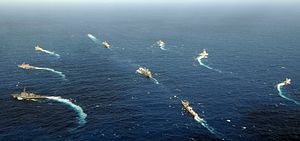India, the United States, and Japan are gearing up for the next iteration of the Malabar series of naval exercises. The exercise this year will take place in the northern Pacific and will involve naval assets from all three countries. The exercise is seen as a symbol of growing trilateral security cooperation between these three democracies. The Malabar exercise will precede India’s “Yudh Abhyas” counter-terror exercise in Uttarakhand, which is scheduled to take place in September with U.S. forces, according to a Times of India report. Both Malabar and Yudh Abhyas represent the two most significant military exercises that the Indian armed forces have been involved in since Narendra Modi and the Bharatiya Janata Party’s (BJP) electoral victory.
According to the Times of India, the Indian navy will be sending four to five ships, including a Rajput-class destroyer and a Shivalik-class stealth frigate. The Diplomat was not able to verify which U.S. or Japanese ships will participate in the exercise. “The warships will first head for the ‘Indra’ exercise with Russia off Vladivostok and then reach the North Pacific towards end-July for the Malabar exercises, which apart from India and U.S. will include Japan,” notes one anonymous Indian official.
The exercise has been regarded by China as an attempt at containment by India, Japan and the United States. Despite China’s participation in the United States’ RIMPAC exercise this year, Malabar continues to be reminder of the burgeoning cooperation between Asia’s largest democracy and its richest one. For China, which lacks immediate access to the Indian Ocean and does not enjoy the immediate access to Pacific sea lines that Japan does, Malabar is a source of concern. India and Japan also conducted their first bilateral naval exercise in 2012 and prime ministers Modi and Abe look keen to continue this trend.
The first time India and Japan jointly held a naval exercise — along with three other nations — China issued a formal demarche. That was for Malabar 2007, which was held in the Bay of Bengal, significantly away from Chinese shores. That this year’s exercise will take place in the northern Pacific is likely to raise Beijing’s ire as tensions remain high with Tokyo over disputed islets in the East China Sea.
China is attempting to reset relations with India following Modi’s election and will be watching India’s continued strategic convergence with Japan closely. Prime Minister Modi is set to visit Abe in Tokyo in early July to expand the strategic partnership between the two countries.

































